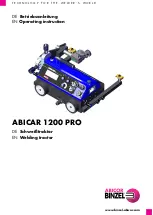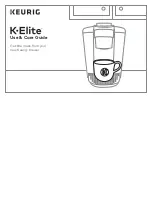
Material Working Temperature
Polyethylene (PE)
550°F
288°C
Polypropylene (PP)
575°F
302°C
Acrylonitrile Butadiene Styne (ABS)
500°F
260°C
Polyvinyl Chloride (PVC)
525°F
274°C
Polyurethane (TPUR)
575°F
302°C
High Density Polyethylene (HDPE)
575°F
300°C
Low Density Polyethylene (LDPE)
520°F
270°C
Testing the weld rod: Temperature setting is correct when the rod becomes
soft and tacky. If the rod starts to liquefy the temperature setting is too hot.
Welding Temperatures: Heat gun temperature settings are important to
welding results. Over heated or under heated welds will result in poor weld
joints and should be avoided.
Practice. The user should practice on a piece of scrap material prior to start-
ing on the repair project. Heat gun temperatures may vary from the working
temperature of the plastic type. Welding plastics takes patience and repetition
to become proficient.
Plastic Welding
Remove the damaged item from cold and windy conditions.
Pre-clean the damaged area with warm soapy water and dry off.
Align parts to be joined by positioning as needed for welding. You may need
to clamp parts.
Install the appropriate welding tip on your Master Proheat Heat Gun. Preheat
the heat gun for approximately 1 minute to desired temperature before
starting the welding process. Use extreme caution. Please read and
understand the instruction manual before use of this tool.
Weld rod should have a clean end to start welding. Trim cut any weld rod with
a used or deformed end. You should also cut the rod to the length of the weld
joint to minimize any weak spot in the weld joint.
Once the heat tool is at the proper temperature, place the heated weld tip
on the surface of the plastic part you need to weld. When the surface of the
plastic part begins to melt, feed your plastic welding rod into the preheated
welding attachment and feed your rod in a steady motion moving your appli-
cator tip along the repair joint. Do not pull on the rod. Let the rod melt into the
joint as you move steadily along the weld joint.
Watch the area where the rod meets the plastic part. You should see a small
MASTER WELDING TIPS
35016
3” (75 mm) Spreader
Spreads air evenly over
wide areas
35017
1 1/4” Shrink attachment
Reflects air around
surface’s such as tubing
or pipe
35266
1 1/2” 40mm Angle Slit
Nozzle
Lap welds roofing
materials
35267
3” (75mm) Teflon Coated
Butt Welding Heat Disc
For butt welding
PVC pipes
35268
1 1/2” (40mm) Lap
Welding Slit Nozzle
For lap welding PVC
Sheeting
35271
Plastic Welding Rod Slit
Nozzle
Use to melt plastic welding
rod, Use w/ 3/8” reducer
35293
5/8” (14 mm) Reducer
Concentrates air flow
35294
3/8” (9 mm) Reducer
Concentrates air flow. Also
used with weld tips
35295
Speed Welding Tip w/
7mm intake
For welding rod up 6mm,
Use with 3/8” reducer
35296
3/4” (20 mm) Lap Weld-
ing Nozzle
For lap welding plastic
materials, Use with 3/8”
reducer
35291
Seam Roller with ball
bearings
For lap welding,
edging tape and
roofing applications






















